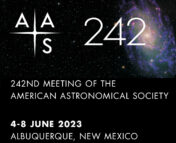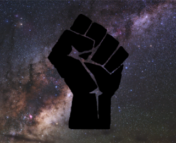In this series of posts, we sit down with a few keynote speakers of the 244th AAS meeting to learn more about them and their research. You can see a full schedule of their talks here, and read our other interviews here!

Meet Dr. Aparna Venkatesan, professor in the Department of Physics and Astronomy at the University of San Francisco, and Dr. Teznie Pugh, Superintendent of the University of Texas at Austin McDonald Observatory. They have been the co-chairs of the Committee for the Protection of Astronomy and the Space Environment (COMPASSE) since 2022.
Dr. Venkatesan works on studies of the first stars and quasars in the universe, and on numerous cultural astronomy and space policy projects. She is deeply committed to improving diversity, equity, inclusivity and accessibility in STEM and to developing respectful scientific partnerships with indigenous communities around the world. Dr. Pugh has worked for more than a decade in observatory operations and management. She works closely with local, regional, and national representatives and organizations on limiting artificial light at night and was a driving force behind the founding of the Greater Big Bend International Dark Sky reserve, the world’s largest dark sky reserve.
As co-chairs of COMPASSE, Dr. Venkatesan and Dr. Pugh will be delivering a joint plenary talk at AAS 244, discussing the need for dark and quiet night skies for the future of astronomy and preservation of the space environment.
The Evolution of COMPASSE: Safeguarding Astronomy and the Space Environment
Since its inception, the Committee on Protecting Astronomy and the Space Environment (COMPASSE) has experienced significant growth in scale and scope, prompting a rebranding from its previous identity, the Committee for Light Pollution, Radio Interference, and Space Debris (LPRISD). The original name and structure had become too limiting in terms of the extent of the causes the team had been working on. This transformation was driven by the need to address emerging challenges and opportunities in astronomy and space policy and culminated in a vibrant, currently expanding committee with a new mission to protect both astronomy and the space environment. Here, space environment broadly refers to the region of the exosphere which is monitored for space weather research and the operation and maintenance of satellites, a term that needs further recognition. The name change of the committee also came about to facilitate increased interactions with federal agencies to advocate for astronomy and space environment protections.
COMPASSE is made up of about 40 members and since the rebranding, it operates under a renewed mission, vision, and values. A new website is set to launch, reflecting its broadened focus: ensuring “the sky for astronomy” and addressing challenges faced by the space environment. The committee’s interests now extend to the lunar and Martian surfaces, highlighting the need to keep pace with the demands of new frontiers in the space race.
COMPASSE is made up of numerous subcommittees focusing on critical issues like space debris, light pollution, community engagement, and radio-frequency interference. The committee’s volunteer base is extraordinarily committed, with each member contributing between five and twenty hours per week. These volunteers actively participate in public talks, podcasts, and meetings, interfacing with entities like the Office of Space Commerce, the Federal Aviation Administration, and the Presidential Science Cabinet.
Journey to the Stars, For the Stars
Dr Venkatesan and Dr Pugh, two prominent figures in COMPASSE, embody diverse paths to engagement with the committee’s mission.
Dr Venkatesan’s path was shaped by her work with indigenous and tribal communities, particularly various Native American groups. Over the past two decades, she witnessed the erosion of oral traditions due to brightening night skies. This has especially impacted indigenous groups, whose history and culture were intertwined with astronomy. Her journey with Noctalgia, a concept now globally recognized, emphasizes the connection between environmental and social justice and the night sky. Noctalgia, derived from solastagia, expresses the grief over the accelerated loss of shared dark skies.
Dr Pugh was set on her journey in graduate school, where she realized the importance of dark skies through outreach. As she switched into more technical positions at various observatories after grad school, her job portfolio that included “site operations and scientific facilitation” required her to have a better awareness of the dark skies. This was complemented by her experience growing up in her hometown, which underscored the loss of scientific curiosity caused by light pollution, especially for those from socio-economic backgrounds limiting their access to dark skies. Having grown up in a poor neighborhood, she really cares about “lighting justice, which can limit someone from wanting to go into STEM, and not just their scientific ability.”
Where the COMPASSE needle pointed: Public Outreach and External Collaborations
Since 2019, COMPASSE has had a continuous presence at four back-to-back AAS meetings, hosting numerous sessions and expanding its membership. New research by the members of the committee focuses on the impacts of light pollution on astronomy, aiming to provide insights into future scientific directions.
COMPASSE values inter-committee engagement, collaborating with groups dedicated to preserving astronomical heritage and promoting sustainability. These efforts have included sessions on sustainability and partnerships with other committees and organizations to broaden their impact, like NOIRLab’s Globe at Night, which promotes citizen science on light pollution. Light pollution also has ecological consequences– affecting the natural cycles of living organisms, disrupting pollination, and impacting animal behavior across ecosystems. This motivates collaborations with national parks, wildlife boards, nature conservatories, and organizations like the Sierra Club to carry out the mission of “protecting dark and radio-quiet skies, and the safe and sustainable use of outer space”. Local ordinances and international frameworks also play a crucial role in combating light pollution and managing space-based challenges. The outreach efforts by this group have reached a wide audience. This includes a large light pollution subcommittee with members ranging from amateur astronomers to planetarium employees. Documentaries such as PBS’s “Defending the Dark” featuring Doug Arion and “Northern Nights, Starry Skies” featuring Jessica Heim, both COMPASSE members, have helped to spread awareness. Public webinars help the “people to get caught up on the issues, [by learning from] cultural astronomers, and historians”. K-12 education not only ties with the mission of raising the next generation of astronomers, but also bridges the gap in astronomy outreach within communities which already suffer a lot of light pollution and may not have access to telescopes for backyard stargazing.
Low earth orbit satellites– blessing or a curse?
Another big part of the space environment policy that Dr Venkatesan and Dr Pugh have been working on are the multitude of satellites that have been launched into low earth orbit (LEO). These satellite networks, popularly known as “satellite constellations” have been vital in connecting the globe and ensuring internet access for millions but pose major challenges for earth-based telescopes. LEO satellites are also used to collect data for environmental and climate science in the pursuit of sustainable solutions and ways to keep global warming in check. While astronomers understand the need for these satellites, the question that has been raised is the relevant scale of the networks– “do we need these many satellites?”. This becomes complicated due to the lack of regulations on satellites. There has to be a way to reap the benefits of these satellites without destroying the outer space environment, i.e. without accumulating a debris field, or contaminating the atmospheres and oceans on re-entry. COMPASSE works with AAS to support intergovernmental and interspace agency statements in this regard, like the zero-debris charter, started by the European Space Agency.
How can you help?
“Talk to us at the meeting!”
Dr Venkatesan and Dr Pugh do not present their cause as yet another crisis, but as a continually unfolding story for the next generation of astronomers– professionals and amateurs– to carry forward. Their work is supported by a large volunteer base, so early career scientists, including undergraduate and graduate students, are encouraged to be a part of this community.
The ultimate goal is to ensure that basic right of being able to access the dark skies. Dark skies should be there for the next generation. Future astronomers need the skies too. Astronomy is after all “a gateway science” that ignites scientific curiosity from a simple act of stargazing.
To hear more about the work done by COMPASSE, tune into Dr. Venkatesan and Dr. Pugh’s Plenary Lecture at 8:00 am CT on Tuesday, June 11 at #AAS244!
Edited by: Lindsey Gordon
Featured Image Credit: AAS




